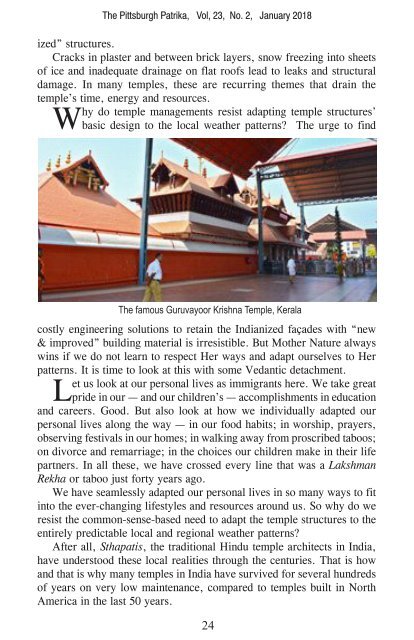Pittsburgh _Patrika_Jan-2018
Create successful ePaper yourself
Turn your PDF publications into a flip-book with our unique Google optimized e-Paper software.
The <strong>Pittsburgh</strong> <strong>Patrika</strong>, Vol, 23, No. 2, <strong>Jan</strong>uary <strong>2018</strong><br />
ized” structures.<br />
Cracks in plaster and between brick layers, snow freezing into sheets<br />
of ice and inadequate drainage on flat roofs lead to leaks and structural<br />
damage. In many temples, these are recurring themes that drain the<br />
temple’s time, energy and resources.<br />
Why do temple managements resist adapting temple structures’<br />
basic design to the local weather patterns? The urge to find<br />
The famous Guruvayoor Krishna Temple, Kerala<br />
costly engineering solutions to retain the Indianized façades with “new<br />
& improved” building material is irresistible. But Mother Nature always<br />
wins if we do not learn to respect Her ways and adapt ourselves to Her<br />
patterns. It is time to look at this with some Vedantic detachment.<br />
Let us look at our personal lives as immigrants here. We take great<br />
pride in our — and our children’s — accomplishments in education<br />
and careers. Good. But also look at how we individually adapted our<br />
personal lives along the way — in our food habits; in worship, prayers,<br />
observing festivals in our homes; in walking away from proscribed taboos;<br />
on divorce and remarriage; in the choices our children make in their life<br />
partners. In all these, we have crossed every line that was a Lakshman<br />
Rekha or taboo just forty years ago.<br />
We have seamlessly adapted our personal lives in so many ways to fit<br />
into the ever-changing lifestyles and resources around us. So why do we<br />
resist the common-sense-based need to adapt the temple structures to the<br />
entirely predictable local and regional weather patterns?<br />
After all, Sthapatis, the traditional Hindu temple architects in India,<br />
have understood these local realities through the centuries. That is how<br />
and that is why many temples in India have survived for several hundreds<br />
of years on very low maintenance, compared to temples built in North<br />
America in the last 50 years.<br />
24


















